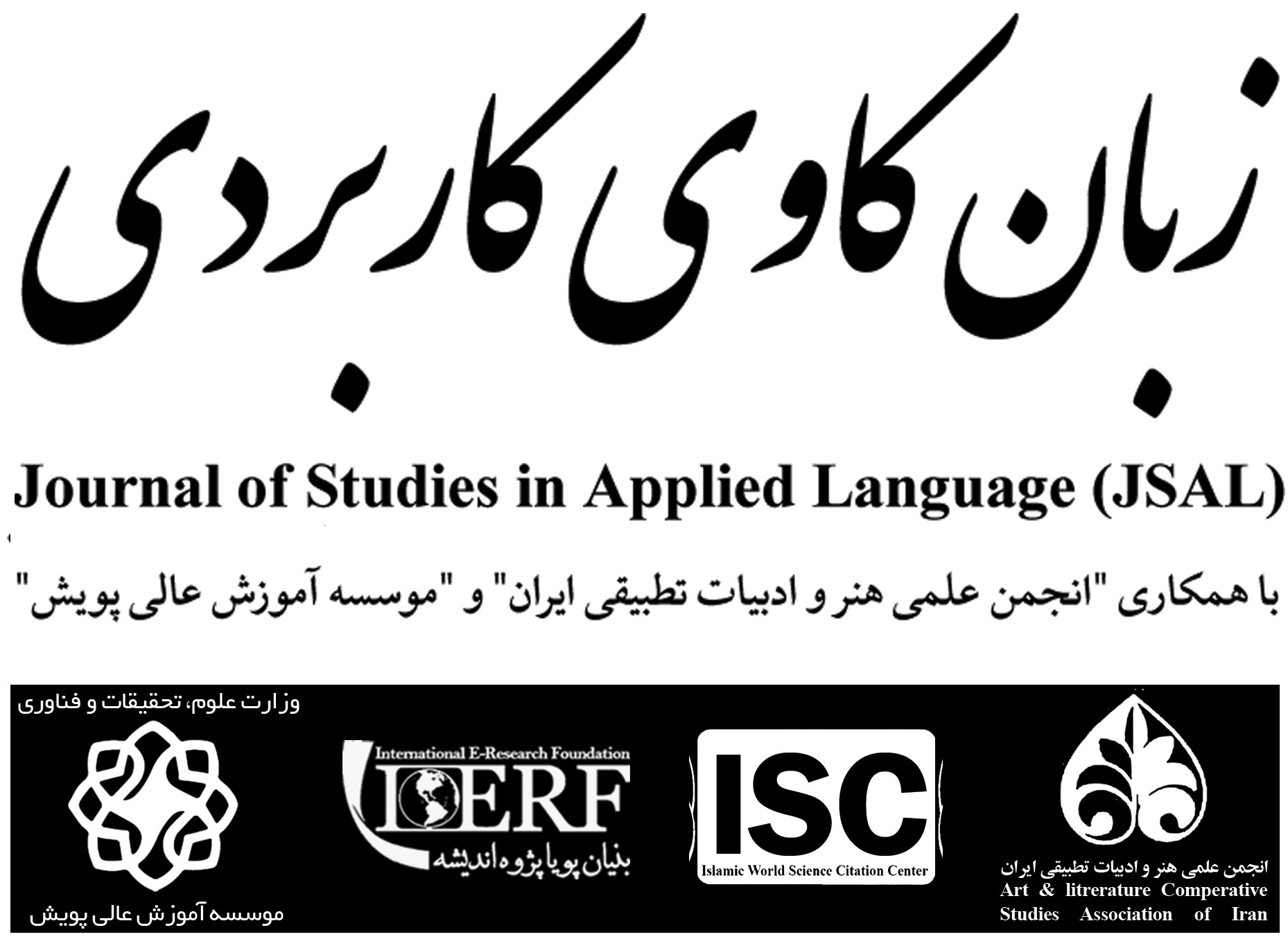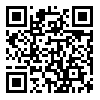دوره 6، شماره 1 - ( 12-1401 )
جلد 6 شماره 1 صفحات 122-101 |
برگشت به فهرست نسخه ها
Download citation:
BibTeX | RIS | EndNote | Medlars | ProCite | Reference Manager | RefWorks
Send citation to:



BibTeX | RIS | EndNote | Medlars | ProCite | Reference Manager | RefWorks
Send citation to:
Mardani T. (2023). Marked and Unmarked Thematization Patterns: A Contrastive Study of Translated and Non-Translated Persuasive Texts [In English]. JSAL. 6(1), 101-122. doi:10.52547/jsal.6.1.101
URL: http://jsal.ierf.ir/article-1-25-fa.html
URL: http://jsal.ierf.ir/article-1-25-fa.html
مردانی توبا.(1401). الگوهای مضمونساز نشانگذاری شده و بدون نشانه: مطالعه متضاد متون متقاعدساز ترجمهای و غیر ترجمهای [به انگلیسی] زبان کاوی کاربردی 6 (1) :122-101 10.52547/jsal.6.1.101
باشگاه پژوهشگران جوان و نخبگان، واحد اصفهان (خوراسگان)، دانشگاه آزاد اسلامی، اصفهان، ایران ، mardani_mars@yahoo.com
چکیده: (5252 مشاهده)
مضمون سازی فرآیند چیدمان فرم، الگوهای هم سان در یک متن است. پژوهش حاضر با هدف بررسی راهبردهای مضمون سازی در متون متقاعدساز ترجمهای و غیر ترجمهای انجام شده است. برای این منظور، نسخه های ترجمه شده یکی از روزنامه های مطرح آمریکا، نیویورک تایمز، و نسخه اصلی روزنامه همشهری (همسان ایرانی) انتخاب شد. بر اساس تحلیل کمی و کیفی ویژگیهای متنی و مضامین نشانگذاریشده و بدون نشان 12 نسخه ترجمهشده و غیرترجمهای از مقالات نظری نیویورکتایمز و همشهری (6 مورد از هر کدام)، این پژوهش با هدف بررسی چگونگی سازماندهی مترجمان انجام شد. مضامین آنها به صورت نشانگذاری شده و بدون نشان و چگونگی ارتباط آن با نسخه های ترجمه نشده، مد نظر قرار می گیرد. در پژوهش حاضر تلاش شده است تا مشخص شود که آیا الگوهای مضمون ساز بر درک جملات تأثیری دارد یا اینکه مضامین نشاندار تأثیری بر مخاطب دارد و آیا این تأثیرات در ترجمه ها و غیرترجمه ها یکسان است؟ یافته ها نشان داد که الگوهای مضمون ساز می تواند به درک متون کمک کند. همچنین نتایج نشان داد که مضامین نشاندار بر مخاطبان تأثیر می گذارد و در متون ترجمه و غیر ترجمه نسبتاً یکسان بود.
نوع مطالعه: پژوهشي |
موضوع مقاله:
آموزش زبان
دریافت: 1401/1/8 | پذیرش: 1401/11/14 | انتشار: 1401/12/10
دریافت: 1401/1/8 | پذیرش: 1401/11/14 | انتشار: 1401/12/10
فهرست منابع
1. Alonso, B. I., & McCabe, A. (1998). "Theme-Rheme patterns in L2 writing". Didactica (Lenguay Literatureura), Vol. 10, pp 13-31.
2. Baker, M. (1992). In Other Words, London and New York. [DOI:10.4324/9780203133590]
3. Barzegar, H. (2008). "Differences between marked and unmarked translation of English thematized sentences regarding their effect on the audience". Retrieved January, 2, 2011.
4. Bell, R. T. (1991). Translation and Translating: Theory and Practice/Gen. ed. GN Candlin (Applied Linguistics and Language Study). L., NY: Longman Group UK Ltd.
5. McCabe, E. A. H., & Belmonte, I. A. (2001). "Theme, transitivity and cognitive representation in Spanish and English written texts". Círculo de lingüística aplicada a la comunicación, Vol. 7, No. 3.
6. Bloor, T., & Bloor, M. (1995). The Functional Analysis of English: A Hallidayan Approach. London: Arnold.
7. Bloor, T., & Bloor, M. (2013). The functional analysis of English: A Hallidayan approach. Routledge. [DOI:10.4324/9780203538098]
8. Brown, G., Brown, G. D., Brown, G. R., Yule, G., & Gillian, B. (1983). Discourse analysis. Cambridge university press. [DOI:10.1017/CBO9780511805226]
9. Butt, D., Fahey, R., Feez, S., Spinks, S., & Yallop, C. (2003). Using functional grammar: An explorer's guide.
10. Gouveia, C. A. (1997). Texts and Practices: Readings in Critical Discourse Analysis.
11. Catford, J. C. (1965). A Linguistic Theory of Translation; an Essay in Applied Linguistics: By JC Catford. Oxford UP.
12. Danes, F. (1974). "Functional sentence perspective and the organization of the text". Papers on functional sentence perspective, Vol. 23, pp. 106-128. Doi: 10.1515/9783111676524.106 [DOI:10.1515/9783111676524.106]
13. Derewianka, B. (2001). Pedagogical grammars: Their role in English language teaching. Analysing English in a global context: A reader, pp Vol 240-269.
14. Downing, A., & Locke, P. (2002). A university course in English grammar. Psychology Press.
15. Dubois, B. L. (1987). A reformulation of thematic progression typology. Text-Interdisciplinary Journal for the Study of Discourse, Vol. 7, No. 2, pp 89-116. Doi: 10.1515/text.1.1987.7.2.89 [DOI:10.1515/text.1.1987.7.2.89]
16. Eggins, S. (2004). Introduction to systemic functional linguistics. A&c Black.
17. Fairclough, N. (2001). Language and power. Pearson Education.
18. Fairclough, N. (1999). Global capitalism and critical awareness of language. Language awareness, Vol. 8, No. 2, pp. 71-83, Doi:. 10.1080/09658419908667119 [DOI:10.1080/09658419908667119]
19. Fairclough, N. (1995). Discourse analysis: The critical study of language. Londres/Nueva York: Routledge.
20. Fang, J., Song, Z., & Wu, C. (2008). "What may be Hidden behind a Translator's Choices: A Comparative Analysis of two Translations of The Art of War. Systemic Functional Linguistics in Use". Odense Working Papers in Language and Communication, Vol. 29, pp. 283-306.
21. Fowler, R. (2013). Language in the News: Discourse and Ideology in the Press. Routledge. [DOI:10.4324/9781315002057]
22. Fries, P. (1995). Personal View of Theme. Thematic development in English texts.
23. Gerrot, L., & Wignell, P. (1994). Making Sense of Functional Grammar: An Introductory Workbook. Australia: Gerd Stabler Antipoden Education Educational Enterprises.
24. Gosden, H. (1992). Discourse functions of marked theme in scientific research articles. English for specific purposes, Vol. 11, No. 3, pp. 207-224. Doi: 10.1016/S0889-4906(05)80010-9 [DOI:10.1016/S0889-4906(05)80010-9]
25. Gosden, H. R. M. (1996). A genre-based investigation of Theme: Product and process in scientific research articles written by NNS novice researchers. Department of English Studies, University of Nottingham.
26. Grzegorek, M. (1984). Thematizatiion in English and Polish: Poznan.
27. Hall, S. (2005). The rediscovery of 'ideology': Return of the repressed in media studies. In Culture, society and the media (pp. 61-95). Routledge. [DOI:10.4324/9780203978092-9]
28. Lyons, J. (1970). New horizons in linguistics (No. 410 N4).
29. Halliday, M. A. K. (1978). Language as social semiotic: The social interpretation of language and meaning. Hodder Education.
30. Halliday, M. A. K., Matthiessen, C. M., Halliday, M., & Matthiessen, C. (2014). An introduction to functional grammar. Routledge. [DOI:10.4324/9780203783771]
31. Halliday, M. A. (1994). An Introduction to Functional Grammar, London: Edward Arnold.
32. & Ruqaiya Hasan. (1976). Cohesion in English. London & New York: Longman. SHELL NOUNS, 131.
33. Halliday, M. (1994). An Introduction to Functional Grammar 2nd edition, London: Arnold.
34. Halliday, Michael and Matthiessen, Christian (2004) An Introduction to Functional Grammar, London: Hodder.
35. Halliday, M. H., & Hasan, R. (1984). "Cohesion in English". In Mei-yun Yue, Cohesion and the Teaching of EFL Reading. Forum, Vol. 31, No. 02, pp. 2-20.
36. Helidejs, H. H. M., & Hasan, R. (1976). Cohesion in English. London and New York: Longman.
37. Halliday, M. A. K., & Matthiessen, C. (2006). Construing experience through meaning: A language-based approach to cognition. Bloomsbury Publishing.
38. Halliday, M. A. K., Matthiessen, C. M., Halliday, M., & Matthiessen, C. (2014). An introduction to functional grammar. Routledge. [DOI:10.4324/9780203783771]
39. Hasselgård, H. (2004). Thematic choice in English and Norwegian. Functions of Language, Vol. 11, No. 2, pp. 187-212, Doi: 10.1075/fol.11.2.03has [DOI:10.1075/fol.11.2.03has]
40. Hodge, R., & Kress, G. R. (1993). Language as ideology, 2thEdition, London: Routledge.
41. Jalilifar, A. (2009). Thematic development in English and translated academic texts. Journal of Universal Language, Vol. 10, No. 1, pp. 81-111. Doi: 10.22425/jul.2009.10.1.81 [DOI:10.22425/jul.2009.10.1.81]
42. Jallilifar, A. R. (2010). The status of theme in applied linguistics articles. Retrieved January 2, 2011.
43. Jallilifar, A. R., & Khedri, M. (2011). Thematic development in English and translated academic text. Academic research genre in Asian context, pp. 335-364.
44. Martin, J. R. (1992). "Theme, method of development and existentiality: The price of reply". Occasional papers in systemic linguistics, Vol. 6, pp. 147-184.
45. Martin, J. R., & Rose, D. (2008). Procedures and procedural recounts. Genre relations: Mapping culture.
46. North, S. (2005). Disciplinary variation in the use of theme in undergraduate essays. Applied linguistics, Vol. 26, No. 3, pp. 431-452. Doi: 10.1093/applin/ami023 [DOI:10.1093/applin/ami023]
47. Nwogu, K., & Bloor, T. (2011). Thematic progression in professional and popular medical texts. In Functional and systemic linguistics (pp. 369-384). De Gruyter Mouton.
48. Prince, E. F. (1981). Towards a taxonomy of given-new information. Radical pragmatics.
49. Reid, J. M., Monaghan, P., & Ruxton, G. D. (2000). "The consequences of clutch size for incubation conditions and hatching success in starlings". Functional Ecology, Vol. 14, No. 5, pp. 560-565. Doi: 10.1046/j.1365-2435.2000.t01-1-00446.x [DOI:10.1046/j.1365-2435.2000.t01-1-00446.x]
50. Richards, J. C., & Schmidt, R. (2002). Longman dictionary of applied linguistics and language teaching. Harlow, UK: Longman.
51. Strauss, A., & Corbin, J. (1990). Basics of qualitative research. Sage publications.
52. Streiner, D. L. (2003). "Starting at the beginning: an introduction to coefficient alpha and internal consistency". Journal of personality assessment, Vol. 80, No. 1, pp 99-103. Doi: 10.1207/S15327752JPA8001_18 [DOI:10.1207/S15327752JPA8001_18]
53. Thompson, G. (2013). Introducing functional grammar. Routledge. [DOI:10.4324/9780203431474]
54. Wang, X. (2009). "Grammatical concepts and their application in foreign language teaching". Retrieved November, No. 19, pp. 335-364.
55. White, P. R. R. Appraisal (in Discursive Pragmatics, Handbook of Pragmatics Highlights).
56. Van Dijk, T. A. (2013). News analysis: Case studies of international and national news in the press. Routledge.
57. Van Dijk, T. A. (2015). Racism and the Press. Routledge. [DOI:10.4324/9781315682662]
58. Van Dijk, T. A. (1993). Analyzing racism through discourse analysis: Some methodological reflections. Sage Publications, Inc.
59. Ventola, E. (1995). Thematic development and translation. Thematic development in English text, pp. 85-104.
60. Yarmohammadi, L., & Amal-Saleh, E. (1995). Textual analysis of English and Persian written texts in contrast and its possible pedagogical implications. Fifteen Articles in Contrastive Linguistics & the Structure of Persian: Grammar, Text & Discourse, pp. 101-123.
61. Zhou, Y. F. (2006). "The interpersonal metafunction and theme in English and Chinese advertisement texts". US-China Foreign Language, Vol. 4, No. 5, pp. 46-50.
ارسال پیام به نویسنده مسئول
| بازنشر اطلاعات | |
 |
این مقاله تحت شرایط Creative Commons Attribution-NonCommercial 4.0 International License قابل بازنشر است. |








